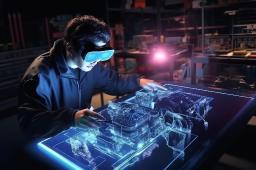

he construction industry, often considered traditional and labor-intensive, is now undergoing a significant digital transformation. One of the key drivers behind this change is generative AI in construction, a revolutionary approach that leverages artificial intelligence to automate design, optimize planning, and improve project efficiency. This technology is not only enhancing productivity but also reshaping how buildings and infrastructure are conceived, designed, and delivered.
Generative AI uses algorithms to generate multiple design options and solutions based on given parameters such as space, materials, budget, and safety regulations. It’s like having an intelligent assistant that offers thousands of architectural possibilities, all while ensuring performance, cost, and sustainability goals are met.
At its core, generative AI in construction involves machine learning models that can process complex data and produce optimized outputs for various construction elements. These can include structural layouts, energy-efficient designs, site utilization plans, and even scheduling and resource allocation.
This form of AI is data-driven and iterative. It doesn’t just deliver one answer; it generates many possible options, which architects, engineers, and contractors can evaluate and refine. By using feedback loops, the model learns and improves, leading to even better outcomes over time.
Generative AI in construction is particularly valuable during the early planning and design stages. It speeds up the conceptualization phase by automating time-consuming tasks like floor planning, structural analysis, and material estimation. What once took weeks can now be done in a matter of hours.
One of the most common uses of generative AI in construction is in architectural design automation. The AI can propose layout configurations based on sunlight patterns, airflow, noise levels, and human behavior. These suggestions are not only creative but are often more efficient and sustainable than traditional designs.
In site planning, generative AI helps determine optimal placements of buildings, roads, and utilities within a given plot of land. It considers topography, accessibility, environmental impact, and zoning laws. The result is a more balanced and efficient use of space.
Structural optimization is another area where generative AI is making a big impact. Engineers can input specific load requirements and building materials, and the AI generates structural frameworks that are safe, lightweight, and cost-effective.
Generative AI is also being used in construction scheduling. It analyzes tasks, resource availability, and dependencies to create the most efficient project timeline. If delays or disruptions occur, the AI can adjust the schedule dynamically to minimize impact.
Furthermore, in modular construction, generative AI assists in creating prefab component designs that fit together seamlessly. This boosts precision and minimizes waste during production and assembly.
The advantages of integrating generative AI in construction are numerous. First and foremost, it drastically reduces design time and manual effort. What used to take architects and engineers weeks to accomplish can now be automated and completed in hours, allowing teams to focus on high-level creativity and decision-making.
Second, it significantly improves cost estimation and resource optimization. By analyzing vast amounts of project data, generative AI suggests materials, layouts, and timelines that reduce waste and improve efficiency. This not only lowers construction costs but also contributes to sustainable building practices.
Third, generative AI enhances collaboration across disciplines. Since the AI can provide multiple scenarios and simulations, architects, engineers, and contractors can align more easily, make better decisions, and reduce design clashes or miscommunication during execution.
Additionally, generative AI contributes to safety and risk management by identifying design flaws or structural vulnerabilities early in the planning stage. This proactive approach helps avoid costly corrections during construction and ensures compliance with building codes.
Despite its benefits, generative AI in construction does come with challenges. One major hurdle is the availability of high-quality data. For the AI models to perform well, they require accurate, up-to-date, and structured data — something not all construction firms currently possess.
Another concern is the need for skilled professionals who can interpret and work with AI-generated outputs. The construction workforce must adapt and acquire digital skills to make the most of this technology.
That said, the adoption of generative AI in construction is rapidly growing. With advances in cloud computing, 3D modeling, and building information modeling (BIM), the integration of generative AI into standard workflows is becoming more seamless and accessible.
Generative AI in construction is not just a trend — it's a transformative force that is redefining how buildings are imagined, designed, and constructed. From design automation to project optimization, this technology offers speed, accuracy, and innovation in ways that were once unimaginable.
As the construction industry embraces digital transformation, generative AI will continue to be a vital tool for solving complex challenges and improving outcomes. By adopting this technology today, firms can future-proof their operations and stay ahead in a competitive, fast-evolving market.
| No comments yet. Be the first. |